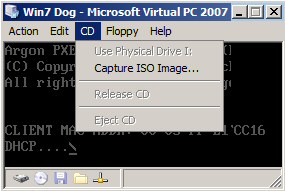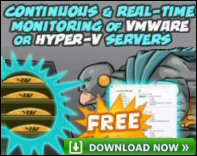How To Install Windows Server 2008 on Microsoft’s Virtual PC
Which ever version of Windows Server 2008 you have, this page will help you install it in Microsoft Virtual PC 2007. Incidentally, if you have been disappointed with previous versions of Microsoft Virtual PCs, please give the 2007 edition a chance, it is much faster.
Installing Windows Server 2008 on Virtual PC
- Introduction to Installing Windows Server 2008 on Virtual PC
- First Goal – Get Your Copy of Server 2008
- Second Goal – Create a Simple Microsoft Virtual PC
- Third Goal – Capture the CD To a Physical Drive
- Fourth Goal – Install Windows Server 2008
- Post Installation and Virtual Machine Additions
- Troubleshooting the Actual Windows Server 2008 Installation
♦
Introduction to Installing Windows Server 2008 on Virtual PC 2007
From the outset, I believed that it would be possible to install Windows Server 2008 on Microsoft’s Virtual PC. My previous experience is installing about about 40 virtual machines on Virtual PC 2004 and Virtual PC 2007.
I choose to install Virtual PC 2007 on a Windows Server 2008 host, even though the setup says explicitly that this host operating system is not recommended. The reason that I mention these two facts is to give you confidence. I want to emphasise that while I am no great expert on Virtual PC, yet I got Windows Server 2008 working relatively easily.
Employing Virtual PC as the host is a good solution for those who don’t have the hardware to use the Hyper-V version of Windows Server 2008.
For experienced techies, who are geniuses at computing, all you need to do is absorb these key concepts:
- Download and install a free copy of Virtual PC 2007.
- Create a new Virtual Machine, this will host the guest operating system.
- Obtain a 32-bit version of your guest operating system, either on DVD or as an image.
- Capture the DVD drive or the image of the Windows Server 2008 (guest) in the Virtual Machine.
- Have patience and faith that your Windows Server 2008 install will work.
For ordinary mortals, I will provide step-by-step instructions to help you install a Windows Server 2008 guest operating system in Virtual PC 2007.
First Goal – Get Your Copy of Server 2008
The Actual Windows Server 2008 image
When you select your Windows Server 2008 image, make sure that you select the 32-bit version (x86) even if the host is installed on 64-bit hardware. It is my understanding that these virtual machines only support 32-bit guest operating systems. To double-check consult the Release Notes.
One new development is there is just one DVD for all editions. Thus it’s just the product key that determines which edition you install from the DVD or .iso file.
Second Goal – Create a Simple Microsoft Virtual PC
My advice is keep the New Virtual PC setup as simple as possible. Just follow the defaults, the one exception is increase the memory for your Windows Server 2008 Virtual Machine from 512 to at least 1GB. By all means adjust the other settings once you have created the machine and installed the operating system.
- From the Virtual PC Console, click New…
- Create a virtual machine.
- Choose a location with at least 40 GB of free space.
- Operating System, select other or Windows Server 2008 it really doesn’t matter.
- Adjusting the Ram – 512 MB Ram is recommended, I choose 2,050 MB.
- A new virtual hard disk.
- Name and Location. Previously, I created a special partition (V:\) on my host machine for VM images.
- Finish.
Third Goal – Capture the ISO Image
If you have a copy of Windows Server 2008 on DVD, then you can skip this step. Else this is the situation so far, we have obtained the ISO DVD image, now we want to boot the Virtual Machine. The problem is that we want to boot, not from the physical CD, but from the bootable ISO image.
What we do in the Virtual PC console, is click on the top menu called ‘CD’ and select – Capture ISO Image.. (See screen shot, but bear in mind that your drive letter will be different from mine.)
̃
Fourth Goal – Install Windows Server 2008
The first few menus were straightforward, the only slight hiccup was obtaining the correct product Key. There is just one DVD (or Image) for all five editions. What makes the difference is the product key that you type. To summarise, Windows Server 2008 Datcenter has a different product key from Windows Server 2008 Standard, even though both could be installed using the same DVD / Image.
Once I clicked on Microsoft’s licence agreement, the install continued by expanding the cabinets, copying files and installing Windows Server 2008’s default features. I returned 50 minutes later and found that the Windows Install had completed successfully.
At the end of this simple install, Windows Server 2008 reboots with a GUI. At this point you should configure initial settings, starting with the Administrator’s password. Next call for the Server Manager and set the machine name, also check the Region and Time Zone. Another bonus was that Windows Server 2008 recognised the United Kingdom keyboard layout that I specified at the beginning of the install.
In terms of efficiency and intelligence, Windows Server 2008 has Microsoft’s best install technology to date. For example, Windows Server 2003 installs are a pain, in that they halt after about 10 minutes and ask you to input networking information.
Guy Recommends : SolarWinds’ Free VM Monitor
The best feature of this new this new version of SolarWinds VM Monitor is that it checks Windows Hyper-V. Naturally, it still works with virtual machines on VMware ESX Servers. VM Monitor is a clever desktop tool that not only tests that your server is online, but also displays the CPU and memory utilization for each node.
It’s easy to install and to configure this virtual machine monitor, all you need the host server’s IP address or hostname and the logon info. Give this virtual machine monitor a try – it’s free.
Download your free copy of SolarWinds VM Monitor.
Post Installation Tasks and Virtual Machine Additions
Call for the Server Manager
Microsoft has decided to make the initial possible as easy as possible. All the information that you previously gave in the install’s text mode, you now configure via ICT (Initial Configuration Tasks) in the Server Manager.
Windows Server 2008 Activation Tip:
If you are installing Windows Server 2008 just to test the features, or out of curiosity, un-check the Activate Online box. My point is that you can legitimately conserve your activation lives. The situation with my genuine MSDN Windows Server 2008 product key is that it can be used up to 10 times. (However other product keys may have different activation properties.) What I suggest is you start with a non-activated installation, then after say a week, either choose to activate your licence online, or re-install with a bigger partition and activate that installation.
Virtual Machine Additions
When the the earlier Windows Server 2008 builds finished installing, I was disappointed, the machine ran unacceptably slowly. Then I remembered the Virtual Machine Additions. In a nutshell installing this add-on transformed my Windows Server 2008 experience.
Solution to Install Virtual Machine Additions
I allowed the Virtual PC to switch to the D:\ Virtual Machine Additions, but then I took over manually and drilled to D:\windows\ and double clicked setup. From here, the Setup InstallShield Wizard appeared, took its time, but installed the Virtual Machine Additions properly.
What lulled me was the fact that Windows Server 2008 had good graphics from the start, and silly me thought the slow performance was down to a checked beta version, the reality was the slow performance was down to lack of Virtual Machine Additions.
Solution to Install Virtual Machine Additions on a Production Version of Windows Server 2008
To install the Virtual Machine Additions ‘by the book’, click on the file menu, Install Virtual Machine Additions, just click ‘Continue’ when the UAC (User Account Control) dialog box prompts you. I will probably never know if my experience with the previous build was user error or a beta bug.
Mouse Trapped in Virtual Machine
One neat improvements with Virtual PC 2007 is the way that the mouse seems to move more seamlessly from the host to the guest operating system. Any problem and just press the right Alt key. (In England this key is labelled ‘Alt Gr’).
Further Post Installation Tasks
I found that the best setting for Network Adapter1 was to select the host NIC. In particular, this configuration cured a specific problem: Virtual PC could not open the Virtual Machine Network Services driver, or The Virtual Machine Network Services driver has failed to install.
My machine was fortunate in having 4 GB of Ram, so I allocated 2 GB to Windows Server 2008. The problem was the Virtual PC Console would not let me use more than 300 MB. The error was: The virtual machine could not be started because there was not enough memory available on the host.
The true problem was interference from other programs, in my case Nero CD burner, in another case SQL. Therefore, try judicious zapping images in Task manager until you find the root cause, I say again, take care ending processes. The safe way would be to remove programs via the Add or Remove Programs.
Footnote
The above problem did not occur with latest version of Windows Server 2008. I credit Microsoft for ironing out that behaviour.
![]() Once you have installed Windows Server 2008 in your virtual machine, you can access it via Remote Desktop from your host machine.
Once you have installed Windows Server 2008 in your virtual machine, you can access it via Remote Desktop from your host machine.
Extra info kindly sent by ‘Trombone’
Installed Windows Server 2008 in VPC04
Installed the VPC04 additions.
Rebooted.
Windows Server 2008 ran slowly to me.
In Windows Server 2008, installed VS05 (I didn’t want to clutter the host OS with software I wasn’t going to use).
Dug through the program files and grabbed the VM Additions ISO from the VS05 install
Dragged file off of Windows Server 2008 and onto XP host
Uninstalled the VPC04 additions from Windows Server 2008
Rebooted
Windows Server 2008 ran very slowly without any additions.
Mounted the ISO as a drive and installed the latest Additions (that came from VS05).
Rebooted
Wow, Windows Server 2008 ran very quickly on my system and went from a struggle of sit and wait to actual usability.
Troubleshooting the Actual Windows Server 2008 Installation
Firewall Problem. I am assuming that your hardware is up to specification. One problem that I encountered was when I tried to join a domain only for the firewall on the server to block the vital ports. I should have research which ports to open, but I just disabled the firewall for enough time for the Windows Server 2008 machine to join the Active Directory Domain.
Proxy Server Activation Problem. If you try to activate the Windows Server 2008 only to get error code 0x8004FE33, then I would phone the automated phone system as directed by the Windows Activation Wizard. The cause of this error is a proxy server which is configured to use only basic authentication, thus you could try disabling basic authentication on the proxy server.
Dirty DVD Disk. If you get a file copying problem during installation it may be dust or dirt on the DVD. I use a clean hanky, or a shirt tail, but your supposed to use a clean cloth. Scratches are more difficult, however, you may find that Microsoft will replace the disk for free, after all it’s the product key that counts. See more on virtualization.
 Guy Recommends: The Free Config Generator
Guy Recommends: The Free Config Generator
SolarWinds’ Config Generator is a free tool, which puts you in charge of controlling changes to network routers and other SNMP devices. Boost your network performance by activating network device features you’ve already paid for.
Guy says that for newbies the biggest benefit of this free tool is that it will provide the impetus for you to learn more about configuring the SNMP service with its ‘Traps’ and ‘Communities’. Try Config Generator now – it’s free!
Download your free copy of Config Generator
Virtual PC 2007 File Types
The whole point of understanding these files types is that you can look out for existing images (.vhd) with a view to downloading them and adding to your virtual machines. These single .vhd files contain structures representing the hard disk, and the all the usual files associated with the (guest) operating system.
Another trick is to copy an existing .vhd file and work with that guest operating system, while preserving the original. For example comparing Vista SP1 (original) with Vista SP2 (copied + SP2 applied). The benefit is saving you time installing the operating system from scratch.![]()
Virtual Machine Hard Drive Image (.vhd) [Big file]
Virtual Machine Settings File (.vmc) [Small inf file]
The only possible confusion is with Virtual PC 2007’s own files which are stored separately in the Program Files –> Microsoft Virtual PC folder.
Creating your own VHD Files
Microsoft has a command line tool called WIM2VHD which allows you to create Sysprep images using Windows 7 as the source. The result is an image file that works with Virtual PC 2007 and Microsoft’s Hyper-V.
Summary of Installing Windows Server 2008 in a Virtual PC
Obtain your copy of Windows Server 2008 by either on DVD (best) or by downloading an Image from connect.microsoft, or MSDN if you subscribe to those Microsoft satellite services. Launch the Virtual Machine console to create a new Virtual disk / image / machine. Capture the image from the CD menu. The actual installation takes about half an hour, but the menus are straightforward. Once you (re-)boot into the GUI, head for the Server Manger.
If you like this page then please share it with your friends
Microsoft Windows Server 2008 Topics:
• Server 2008 Home • Overview • What’s New? • Migration Advice • Install • SP1 Review
• AD DC • Roles • Features • Editions • Hyper-V • UAC • IPv6 • Group Policy • Free NPM Trial




